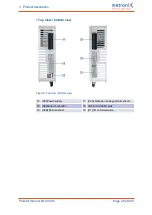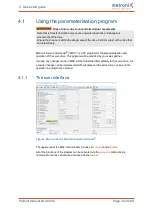
2 For your own safety
2.8
Protection against electric shock by way of
protective extra-low voltage (PELV)
Dangerous electrical voltage!
There is a risk of high electrical voltage due to incorrect electrical connections.
Always follow the safety instructions stated hereinbelow.
All of the connections and terminals with voltages up to 50 V of the servo drive have
protective extra-low voltage. They are protected against contact in accordance with IEC
61800-5-1 and EN 61800-5-1.
Only devices, electrical components and wires or cables with protective extra-low voltage
(PELV) may be connected to connectors and terminals with voltages from 0 to 50 V.
When connecting voltages and circuits, ensure that they are securely isolated from any
dangerous voltages. This isolation can be realised by way of isolation transformers, safe
optocouplers or battery operation without mains power.
2.9
Protection against dangerous movements
Risk of injury due to dangerous movements
Always follow the safety instructions stated hereinbelow.
Dangerous movements can be caused by the faulty actuation of the connected motors.
Causes may be as follows:
l
improper or faulty wiring or cabling
l
errors during the operation of the components
l
errors of the sensors and transducers
l
defective or non-EMC-compliant components
l
software errors in the superordinate control system.
These errors can occur directly after the activation of the device or after some time during
the operation.
The monitoring systems in the drive components exclude any malfunction in the
connected drives to the greatest possible extent. However, in view of the protection of the
operators, particularly in terms of the risk of injuries and damage to property, relying solely
on this measure is not recommended. Until the built-in monitoring systems become
effective, faulty drive movements should always be anticipated. The extent of these faulty
drive movements depends on the type of control and on the operating state.
For the reasons mentioned above, protection must be ensured by monitoring or by
superordinate measures. This must be implemented by the system manufacturer based
on the specific system situation and on a hazard and fault analysis. This also includes the
Product manual BL 4000-C
Page 22 of 298
















































